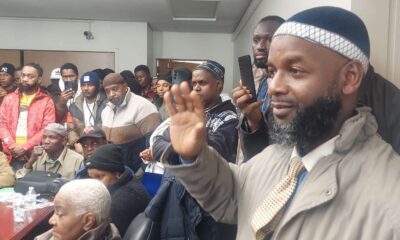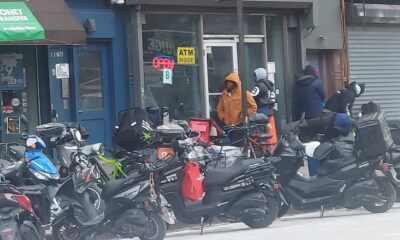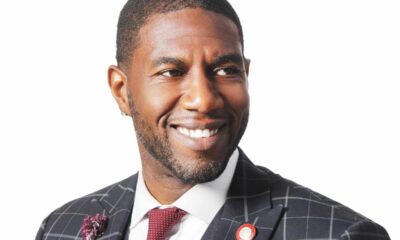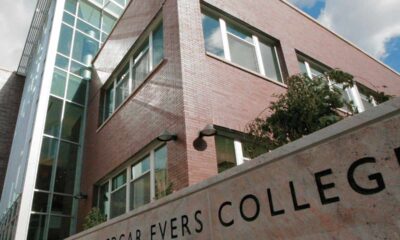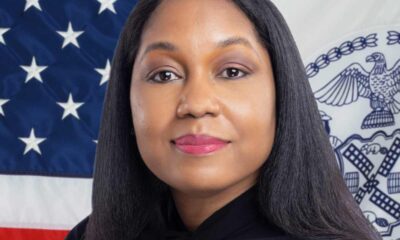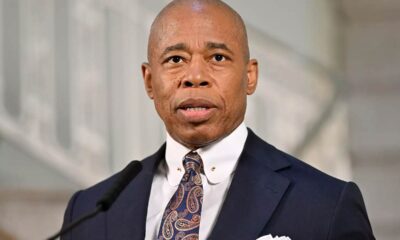Community News
The Migrant Crisis and Its Impact in Brooklyn
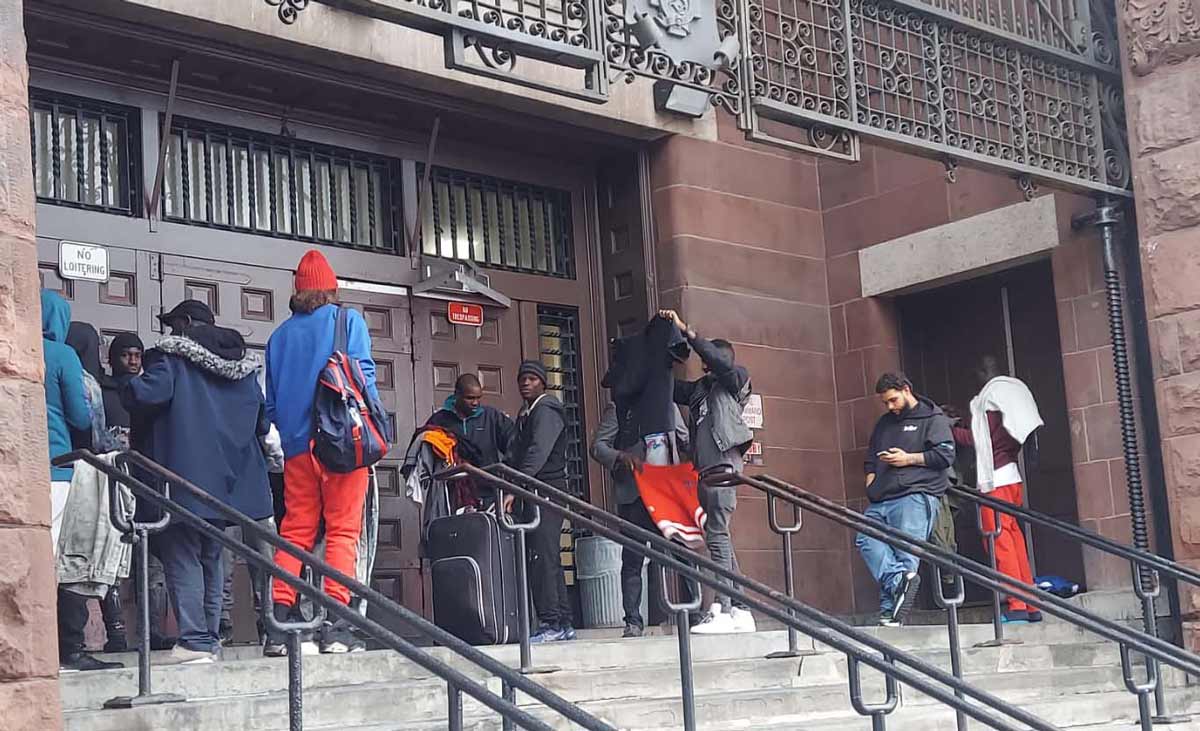
Nayaba Arinde
Editor at large
“Brooklyn, like all of New York City, is built by immigrants from every era and generation,” Public Advocate Jumaane Williams told Our Time Press. “The logistical and fiscal challenges of this moment of crisis are real, and so is our obligation to respond with love and compassion— it’s the Brooklyn way.”
Brooklyn, like the other four boroughs, is tackling the massive social, economic, and political issue of the Texas and Florida politically-motivated busing of thousands of individuals who crossed the Southern border. People are eager to make better lives for themselves and their families. They want to work. Have a home. Send their children to school.
The reality is though, in Brooklyn, food delivery workers and their electric, motorized, and push-iron bikes clutter busy thoroughfares and street corners. Riders, with no discernment for regular pedestrians, zoom along the sidewalk as they go about their business.
But also, dozens upon dozens of businesses are hiring the asylum-seeking migrants across the board. They are assisting the local economy.
A large portion of the traditional demographic that Our Time Press serves are: mostly African American, Black indigenous, and those who have migrated from different parts of the African and Caribbean Diaspora.
Neighborhoods like Bed Stuy, Crown Heights, Brownsville, and East New York are seeing a visible increase in the new asylum-seeking migrant communities from Latin America and West Africa.
Main vein streets like Pitkin Avenue, Nostrand Avenue, Fulton Avenue, and Atlantic Avenue, in the last few months, have become popular hangout spots, where members of the 116,000 people who arrived in New York as part of the ‘Migrant Crisis.’
“Some low-income and no-income people in the Black and Brown community feel that they are being stepped over as a people who have been here suffering, for a new group of people who are also in need,” said Wilmon Cousar, the activist educator. “There is a blatant disparity.”
When the City ran out of shelter space, hotels, school gyms, churches, previously semi-abandoned properties, and purpose-built tent-like cities, became options.
But, the startling image of hundreds of asylum-seeking migrants sleeping outside the Roosevelt Hotel, may be used to illustrate the NYC migrant crisis for years to come.
Wanting to remain anonymous for confidentiality purposes, a Brooklyn-based shelter worker told Our Time Press, “Working in the shelter system I have experienced the positive and negative effects. People who are just coming are able to create stable lives for themselves, and their families with assistance from the government. However, those who have been here for years, aren’t qualified for the benefits the migrants are.”
Pleading for more federal aid, Mayor Eric Adams declared on September 7, 2023. “I don’t see an ending to this. This issue will destroy New York City.”
A NYC-based psychotherapist wishing to remain anonymous told Our Time Press, “One of the concerns with the Migrant Crisis in NYC is that homeless individuals currently placed in NYC shelters are being moved from their current shelters to other shelters to make room for the migrants. An individual I am working with has reported being moved to a shelter that is less safe and clean environment, and close to their services. One client has been moved to a shelter in Queens from Manhattan. She was receiving services in the Bronx and now has to travel 90 to 120 minutes for her treatment services.
“She also reported that she is next to a shelter for men with mental health issues, and is subjected to the men exhibiting inappropriate sexual behaviors (masturbation and exposure) as she walks down the street. This is ridiculous and unfair. She has been waiting 4 years and now has begun the process again because of the relocation.”
As if in response to such on-the-ground concerns, this week, on Tuesday, September 26, 2023, Mayor Adams announced his new plan for the City Fighting Homelessness and Eviction Prevention Supplement (CityFHEPS) rental assistance program. The innovation says the Mayor’s office “will immediately and significantly expand access to housing for New Yorkers with housing vouchers.”
Adams stated that while New York City continues to face a serious housing shortage with a record-high shelter population totaling more than 113,000 individuals in the city’s care, CityFHEPS voucher holders will now be able to utilize their voucher to obtain permanent, affordable housing, and hopefully a job.
“As a result of a housing crisis and more than 116,000 asylum seekers arriving in New York City asking for shelter since last spring, we have more people than ever in the city’s care,” said Mayor Adams.”
He said that approximately 10,000 migrants continue to arrive in the city seeking shelter every month.
Meanwhile, he added, “State law dictates that the overwhelming majority of asylum seekers are not eligible for non-emergency, ongoing assistance and thus are not eligible for CityFHEPS, including this expansion.”
Our Time Press went to the Bedford Armory on Bedford and Atlantic Avenue on the Crown Heights/Bed Stuy border.
There by phone, fellow asylum seeker Sid Fall translated for Mamadou Ndiaye from Mauritania and, from Senegal, Ndiaye Diop and Mood Toure.
Ndiaye said he traveled by plane, bus, and foot via Nicaragua, and Mexico, and through 5 other different countries, in order to get to NYC. “I was escaping slavery in Mauritania,” he said. “Now, I am here at the shelter hoping to get my papers so I can work.”
Diop and Toure said it was “the political climate which made us leave.” Diop said he came via “Istanbul to get to the border.”
“We just want to work, so we are waiting to get our papers,” said Fall. A car pulled up and gave a bag of food to the men.
Moments later a van pulled up with a man delivering men’s clothes. Men poured out of the formidable front doors of the shelter and descended upon the vehicle. The van was emptied in mere seconds. Men draped pants, polo shirts, and sweatshirts over their shoulders. Many had nothing at all.
This is daily.
Cousar, echoing a sentiment expressed by many. “We have homeless veterans, long-term homeless, and our young people out on the streets with no resources. They’re not taking care of the poorest of the people here. They don’t take care of veterans who fought in their wars, so they’re not going to take care of civilians. Meanwhile, all the migrants and asylum seekers are able to take advantage of resources that others are not afforded. But based on humanity we have to help those who need help.”
Looking at the global picture, he added, “America is looking like we are helping people here while meddling with their governments and domestic policies abroad.”
After President Joseph Biden extended the Temporary Protected Status for Venezuelan migrants last week, City Council Speaker Adrienne Adams said the action was a “way to chart a path towards expedited work authorization for tens of thousands of Venezuelans in our city, and more nationally, as they move through the asylum process.”
“Nobody wants to leave their home if they don’t have to,” said Murad Awawdeh, Executive Director of The New York Immigration Coalition in an op-ed, thanking Biden, he said the president should go further “extending and re-designating TPS for Venezuela, people who were forced to flee the violence and instability of Venezuela’s collapsing government will now have a fair shot at remaining safe and secure in the United States.”
Awawdeh added that this will allow the 60,000 Venezuelans who have arrived in New York in the past year “to quickly acquire work authorizations and immediately start contributing to our local economy and communities.”
Awawdeh added the Biden administration must also re-designate TPS for countries like Honduras, Cameroon, Sudan, South Sudan, and Nepal; and create new TPS designations for nations such as: Guatemala, Mauritania, Nigeria, Mali, the Democratic Republic of Congo (DRC), Senegal, and Haiti.
Gov. Kathy Hochul just announced that she is deploying 2,200 members of the National Guard. Out of that number 250 will be working as case managers for asylum seekers. “I believe they did not come all these thousands of miles to live in a shelter with hundreds if not thousands of others.”
From pandemic to the current migrant crisis the Brownsville Community Culinary Center has helped feed tens of thousands of those in need.
“There is a great daily need to serve the underserved, compounded by an equally great need from the new migrant community,” Brownsville Community Culinary Center (BCCC) advisory board member Daniel Goodine told Our Time Press. Jennette Lugo’s Agape Food Rescue in conjunction with the BCCC have had everyone from “homeowners and the homeless on the line. In the neighborhood we see an increase in people coming from all over Brooklyn to pick up food.
Before the migrants arrived, Chef Markees Pruitt and his company 88 PlacePruitt said that he and his company 88 Place were just catering for schools, churches, and private dinners. “I still do catering, but now I also cook for the migrants, 1000 meals a week, sometimes more.”
With the previously served community, Pruitt said, “Now 2000 meals a week come out of here definitely.”
Erick Latino, 29 is a migrant who works at BCCC, who said, “I work for Agape Food Rescue, and everything I do is for the community because I’m here helping the people. I came from Nicaragua 9 months ago. I got my working papers and the government has approved my asylum.”
“We are the Ville, Brooklyn,” said Goodine. “We help as many as we can, as often as we can.”
Nayaba Arinde is Editor-at-Large Our Time Press


